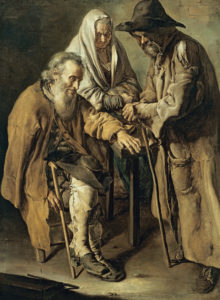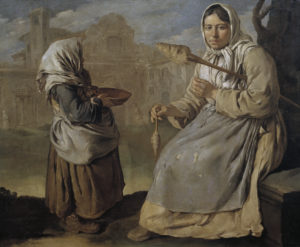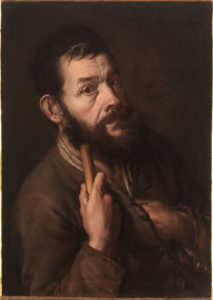Giacomo Ceruti is one of the masters of Italian painting in the 18th century. This artist is also known by the nickname of “Pitocchetto” (“the little beggar”), because of the compelling portraits of beggars, vagrants, and impoverished workers which form a large part of his production.
Despite his popularity in life, art historians of later generations largely looked down on Ceruti’s humble subjects, and he was all but forgotten after his death. His genius was rediscovered only in the 20th century, partly thanks to the fortuitous finding of 12 large paintings known as the “Padernello cycle” in a castle near the city of Brescia in northern Italy.

One could say that Ceruti’s comeback is complete with the arrival of a major exhibition of his work at the Getty Center, the first of its kind to come to the U.S. Running through Oct. 29, “Giacomo Ceruti, A Compassionate Eye” brings together 17 of Ceruti’s finest works.
There are more than a few aspects that make this one of the Getty’s most important exhibits in recent years. The quality of Ceruti’s painting is extraordinary, and his realistic style and sympathetic attitude make his works easy to appreciate even for those with no particular knowledge or interest in painting. And it’s hard to believe that the exhibit’s destination is by chance, in a city where the plight of the homeless and those living on the margins of society has never been more visible.
According to art historian Tom Nichols (“The Art of Poverty,” Manchester University Press, $114.64), there are two major trends in the way European artists depicted the poor from the 16th century onward. An ‘ironic’ approach was predominant in Northern Europe, where the destitute were stereotypically depicted as lazy, deceitful, and morally debased. In the Catholic world, however, an idealized view prevailed which looked at the impoverished individual as “another Christ” (“alter Christus”).

The work of Caravaggio marked a major turning point in this tradition. He was the first to devote large canvases to everyday life scenes featuring peasants and commoners. And he abolished the distinction between sacred and profane by bringing his poor peasants into the picture with Jesus, Mary, and the saints. There was an outcry when his “Madonna di Loreto” was uncovered and viewers noticed the dirty feet and scrappy hat of the pilgrims depicted at the Virgin Mary’s feet.
Ceruti comes from the same area of Italy as Caravaggio, and his approach is influenced by the great Lombard master. But Ceruti went even further. He granted the outcasts of the time — the beggars, the homeless, the physically and mentally disabled — the space and dignity that had so far only been granted to the nobles and to historical characters.
The first painting in the exhibition depicts an elderly beggar, sitting alone against a blurred background. He looks at the viewer as if to ask for help, with a bundle of clothes — probably the extent of his possessions — in his hands.

Until Ceruti’s time, commoners were depicted according to pre-existing “types.” In Ceruti’s paintings, we are looking at real people, with their unique stories and characters. Ceruti’s art restores to them the dignity of being human, and we empathize with them as we recognize them as part of the human family.
Ceruti does not idealize his subjects, though, and there is no overt moralistic intent in his art. Take the exhibit’s impressive portrait of two men playing cards. The two are sitting at a table with a jug of wine, their stupefied faces suggesting it is not their first. One of them, dressed in a worn-out military cloak, is probably an ex-soldier and holds a kitten in his hands. Clearly these two are no moral paragons, yet the painter embraces their whole humanity, with its weaknesses and flaws. They are who they are, and they have been found worthy of representation.
Or take the painting of a man of short stature. In Ceruti’s sensitive rendering, this unusually short man dominates the background, his almost heroic figure like a monument emphasized by the low point of view. But this hero is dressed in rags, and in his eyes, there is the sadness and tiredness of a long struggle against poverty.
For Ceruti’s time, this was a revolutionary painting. The life of this man, an outcast, is now a work of art. The viewer is meant to be struck by the sophistication with which he is painted, in a work that’s hard not to find beautiful. Instead of turning away our heads, we are compelled to look at this man with compassion.

One of the most telling paintings is the artist’s mesmerizing self-portrait as a pilgrim. Pilgrims and beggars are sometimes hard to distinguish in Ceruti’s works: they look the same with their worn-out clothes, tattered shoes, and walking sticks.
Pilgrims and beggars both live day by day, in precariousness, depending on the generosity of others. But unlike beggars, forced into poverty by the circumstances of life, pilgrims have chosen this condition for themselves in the hope of saving their souls.
No doubt Ceruti wished to be identified with the men and women he painted. One could say that, just as a pilgrim, he had chosen to share their lot by making them the subject of his art. Perhaps Ceruti was suggesting that there is something precious in the condition of a pilgrim, somebody who has voluntarily accepted a life of precariousness and dependency.

Here lies one of the crucial takeaways of this exhibit. On the one hand, there is an imperative to relieve the condition of those suffering, because we are all part of the human family. The Italian painter Salvator Rosa attacked the hypocrisy of those who “love painted what they loathe in life.” In this month’s papal prayer intention, Pope Francis warned against a culture of indifference so pervasive in our society that “our necks are going to get stiff” from constantly turning away from the suffering of marginalized people. Ceruti’s art is the perfect antidote to this.
But this Italian master’s art also points to an even more fundamental theological truth: that the poor are closer to the kingdom of God than we are. In a society obsessed with comfort and control, Ceruti’s portraits suggest that perhaps the road to happiness is the one taken by the pilgrim.
We spend our lives planning ahead for the future, striving to eliminate the unexpected. But what if, Ceruti seems to ask us, true freedom comes from living day by day, like pilgrims, abandoned to the will of another?

